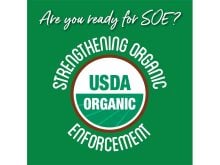LINDELL BEACH, B.C. — Adding natural plant extracts to cattle feed may reduce levels of ammonia gas while also reducing the need to fortify feed with expensive protein supplements.
J. Mark Powell, a soil scientist with the U.S. Department of Agriculture, says 25 to 30 percent of the crude protein consumed by cattle ends up in the milk while 70 to 75 percent ends up in urine and feces.
“For dairy farms, cow urine is the source of the ammonia emission problem,” he said. “(Each) dairy cow excretes large amounts of urine, about 3.5 gallons daily. That’s almost 1,300 gallons (almost 5,000 litres) per year. And there are 10 million dairy cows in the United States alone. Cows usually are fed a high protein diet and they produce various nitrogen compounds when they digest protein. They release the excess nitrogen mainly in their urine, and enzymes convert it into ammonia.”
Read Also

U.S. bill could keep out Canadian truckers
The Protecting America’s Roads Act, which was tabled in the U.S. House of Representatives at the beginning of October, would “rid the country of illegal immigrant commercial truck drivers and ineligible foreign nationals.”
Recent studies have found that adding plant substances called tannins to cow feed affects ammonia emissions from dairy barns and farm fields that have been sprayed with manure.
“What happens with the tannin is that it can bind onto the feed protein and make it less digestible in the rumen,” Powell told the American Chemical Society’s national meeting and exposition this summer.
“It gets into the small intestine, where it is used much more efficiently. Tannin actually retards the digestive process.”
They appear to reduce urea production by allowing more protein to escape digestion in the stomach and enter the cow’s intestines, where it is used to produce milk protein.
Powell first began investigating the value of tannins 20 years ago in West African communities where he lived and worked.
“The tannin concentration in plants in the tropics is much higher than elsewhere,” he said.
“It acts as one of those protections against insects and against over-browsing by small ruminants. Shrubs rich in tannins were used as windbreaks to reduce soil erosion. The leaves became a food supplement.”
Leaves falling from the plants aided in soil fertility because the tannin in the leaves slowed decomposition in the soil. Tannin is found in many hardwoods such as maple, oak and chestnut. Fruits given off by those trees are also rich in tannin.
Tannin is most commonly associated with the leather industry, where it is derived from organic products.
However, further research will be necessary to develop a synthetic product if Powell’s work expands the use of tannin into a significant agricultural feed supplement.
“Tannins, their chemistry and their complex compounds are little understood,” said Powell.
“The research is being started at a fundamental stage right now. What we’ve done is that we’ve extracted them with different solvents to try to get heavy compounds, light com- pounds, and water soluble compounds. Once we can find the particular compound class that has the effect of inhibiting ammonia, then we can take that class of compounds and try to understand what the specific compounds are within that class.”
Powell is working with chemists to understand how the natural compound works, but a critical part of the research will be to understand how those compounds react when the tannin is processed into a feed.
Tannin could be added to feed on the farm as a supplement to the daily diet, into forage before it goes into the silo or into concentrates at the feed mill.
However, researchers don’t know what happens to the tannin during processing or whether heat affects its effectiveness.
One of Powell’s colleagues from Australia conducted a study to incorporate tannin into a concentrate but found that the tannin lost its impact.
“He was quite puzzled as to why,” said Powell. “We wondered whether the process of getting the tannin into the concentrate neutralized it.”
Another research project is determining whether tannins can reduce emissions of methane gas from cattle belches.
“Now that we have multi-gas analyzers, we can actually analyze tannins’ impact on ammonia, methane, carbon dioxide and other volatile organic compounds.”
















